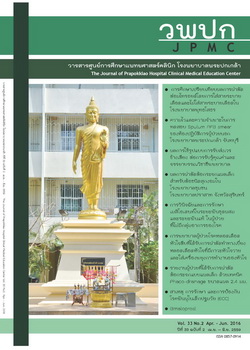ผลการผ่าตัดต้อกระจกแผลเล็กสำหรับต้อชนิดสุกงอม ในโรงพยาบาลชุมชน โรงพยาบาลปราสาท จังหวัดสุรินทร์
Main Article Content
Abstract
ที่มาของปัญหา : โรคต้อกระจก หมายถึง การเกิดเลนส์ตาขุ่น เป็นสาเหตุอันดับหนึ่งที่ทำให้ตาบอด ในปัจจุบันสามารถรักษาได้โดยการผ่าตัดนำเลนส์เดิมที่ขุ่นออก และใส่เลนส์แก้วตาเทียมทดแทนทำให้การมองเห็นดีขึ้น ซึ่งโดยทั่วไปเลนส์ตาจะค่อยๆ ทึบไปเรื่อยๆ หากไม่รักษาจะเกิดอาการที่เรียกว่า ต้อกระจกสุก เกิดเลนส์ตาขุ่นทั้งคอร์เท็กซ์และนิวเคลียส เลนส์ตาจะแข็งตัวมาก ทำให้ตาบอดได้
วัตถุประสงค์ : เพื่อรายงานการมองเห็น และภาวะแทรกซ้อนจากการผ่าตัดต้อกระจกสุกแผลเล็กโดยไม่ใช้เครื่องสลายต้อกระจก
วัสดุและวิธีการ : รูปแบบวิจัยเป็นการพรรณนาแบบย้อนหลัง ศึกษาย้อนหลังจากเวชระเบียนของ ผู้ป่วยต้อกระจกสุกที่มารับการผ่าตัดที่กลุ่มงานจักษุ วิทยา โรงพยาบาลปราสาท จังหวัดสุรินทร์ ระหว่างเดือนตุลาคม 2556 ถึง ตุลาคม 2557 จำนวน 120 ตา โดยนำการบันทึกข้อมูล อายุ เพศ ภาวะแทรกซ้อน การมองเห็นหลังผ่าตัดโดยวัด ระดับสายตาก่อนการแก้ไขและระดับสายตาที่แก้ไขแล้วที่ 1 สัปดาห์ 6 สัปดาห์ และ 3 เดือน ซึ่งการผ่าตัดต้อกระจกสุกแผลเล็กโดยไม่ใช้เครื่องสลายต้อกระจก และ ใส่เลนส์แก้วตาเทียมใช้วิธี Ruit technique โดยเปิดแผลอุโมงค์ตาขาว (scleral tunnel) ขนาด 6.5 ถึง 7.0 มม. ทางหางตา (temporal) และเย็บปิดแผลอุโมงค์ตาขาวในบางราย
ผลการศึกษา : ในผู้ป่วยทั้งหมดเมื่อวัดการมองเห็น หลังการผ่าตัด ด้วย snellen chart มีค่าการมองเห็นดีขึ้นทุกราย โดยระดับสายตาก่อนการแก้ไข (uncorrected visual acuity : UCVA) ดีกว่าหรือเท่ากับ 6/18 หลังผ่าตัด 1 สัปดาห์ 74 ตา (ร้อยละ 61.7) หลังผ่าตัด 6 สัปดาห์ 107 ตา (ร้อยละ 89.1) และหลังผ่าตัด 3 เดือน 113 ตา (ร้อยละ 94.2) ระดับสายตาที่แก้ไขแล้ว (best corrected visual acuity: BCVA) ดีกว่าหรือเท่ากับ 6/18 หลังผ่าตัด 1 สัปดาห์ 108 ตา (ร้อยละ 90.0) หลังผ่าตัด 6 สัปดาห์ 119 ตา (ร้อยละ 99.2) และหลังผ่าตัด 3 เดือน 120 ตา (ร้อยละ 100) การติดตามการรักษาหลังผ่าตัด 3 เดือน ส่วนใหญ่มีระดับสายตาคงที่ ภาวะแทรกซ้อนพบถุงหุ้มเลนส์ฉีกขาด 7 ตา (ร้อยละ 5.8) เลือดออกช่องหน้าม่านตา 5 ตา (ร้อยละ 4.2) และกระจกตาบวม 3 ตา (ร้อยละ 2.5)
สรุป : จักษุแพทย์สามารถผ่าตัดต้อกระจกด้วยวิธีแผลเล็กแม้ในโรงพยาบาลจะไม่มีเครื่องผ่าตัดสลายต้อกระจกโดยใช้คลื่นความถี่สูง (phacoemulsification) การผ่าตัดต้อกระจกสุกด้วยวิธีแผลเล็กโดยไม่ใช้เครื่องสลายต้อกระจก ผลการผ่าตัดทำให้การมองเห็นหลังผ่าตัดดีขึ้น และประหยัดค่าใช้จ่ายในการผ่าตัด
คำสำคัญ : การผ่าตัดต้อกระจกด้วยวิธีแผลเล็กโดยไม่ใช้เครื่องสลายต้อกระจก การผ่าตัดต้อกระจกด้วยเครื่องผ่าตัดสลายต้อกระจกโดยใช้คลื่นความถี่สูง ภาวะแทรกซ้อน การมองเห็น ruit technique ต้อกระจกสุก
Visual outcome of Manual Small Incision Cataract Surgery (MSICS) in Mature Cataract at Subdistrict Hospital, Prasat Hospital, Surin Province.
Background : Cataract is the leading cause of blindness but it can be cured by performing an operation with intraocular lens implantation, untreated patient may be risk of having incurrence diseases in mature cataract, which can turn to blindness.
Objective : To report visual outcome and complications of manual small incision cataract surgery (MSICS) in mature cataract.
Design : Retrospective descriptive study.
Material & methods : The medical records of 120 eyes for 120 patients with mature cataracts scheduled to undergo routine cataract surgery using the manual small incision cataract surgery (MSICS) in Prasat Hospital, Surin between October 2013 - October 2014 were retrospective reviewed. MSICS using a temporal scleral tunnel incision (the Ruit technique) and intraocular lens implantation were performed through an unsutured or only one suture which was 6.5 to 7.0-mm scleral tunnel incision. Uncorrected and corrected visual acuity, intraoperative and postoperative complications were recorded. Patients were examined at the first day, 1st week, 6th weeks, and 3th months after surgery.
Results: All patients had improved visual acuity after surgery. Uncorrected visual acuity (UCVA) was 6/18 or better in 74 eyes (61.7 percent) at 1st week, in 107 eyes (89.1 percent) at 6 weeks and in 113 eyes (94.2 percent) at 3 months after operation. The best corrected visual acuity (BCVA) was 6/18 or better in 108 eyes (90 percent) at 1st week in 119 eyes (99.2 percent) at 6th weeks and in 120 eyes (100 percent) at 3 months. The results remained stable at after 3 months after operation. Complications were accidental posterior lens capsule rupture with vitreous loss 7 eyes (5.8 percent), hyphema 5 eyes (4.2 percent) and corneal edema 3 eyes (2.5 percent).
Conclusion: MSICS is a safe and effective procedure for cataract surgery in the patient with mature cataract.
Keywords: manual small-incision cataract surgery; phacoemulsification; complications; visual acuity; Ruit technique; mature cataract.

